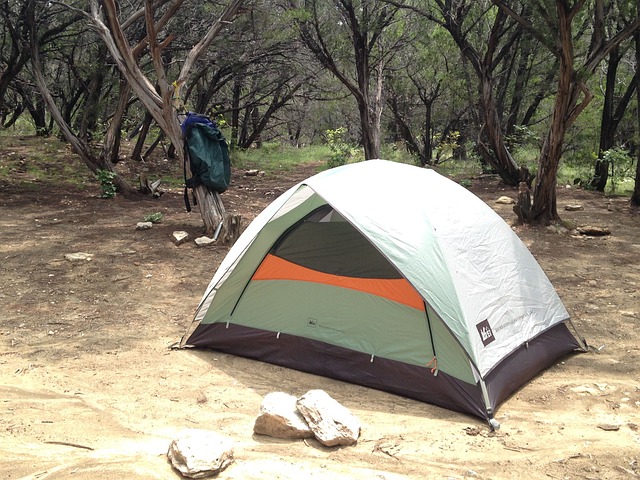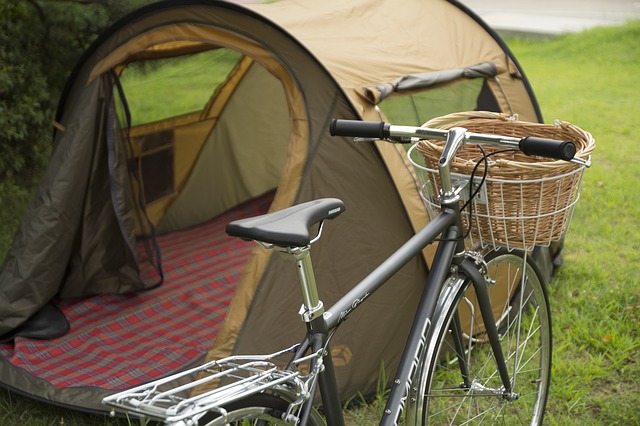I will be explaining inside this very article exactly what a rain fly is for your tent and why they are so important for your outdoor adventures.
Basically, you are going to learn everything that you need to know about rain flies.
Even I had no idea what they were used for when I first started camping, which is why I want to help others that are in the same boat.
Keep reading to see what rain flies are all about for your tent.
What is a Rain Fly?

You’ve probably noticed a piece of fabric that goes over top of your tent and wondered why the heck you need one for.
Well the simple answer is: A rain fly stops rain from getting inside the tent, it’s as simple as that.
Most tents are not waterproof, so they rely on a rain fly to resist the rain, ultimately to keep you, your camping buddies, and everything else dry.
Types Of Rain Flies
Full-coverage – What the heck is a full-coverage rain fly? These are mostly used for campers that are adventuring in high winds and heavy downpours.
The reason why a full-coverage rain fly does such a great job is because they are known to stop 99% of the wind coming into the tent while ensuring NO rain water will make its way under the fly and into the tent.
Half-coverage or partial – Then you have the half/partial-coverage rain flies. They DO get the job done, but not quite as good as the full-coverage rain flies.
These cover the important parts of the tent (the sleeping areas), ensuring you will stay bone dry in a torrential downpour.
But because they don’t cover the entire tent, you will feel the outside cold a lot more, so extra blankets is a must if you want to survive the night.
But Do You Even Need One?
Yes.
In most cases, a tent does require a rain fly to allow it to function properly.
As I have outlined already in this article, tents are not made to be waterproof, so additional fabric (like a rain fly or tarp) is needed to resist the rain as much as possible.
But in saying that, some types of tents (although not many) can be pitched and ready to go without a rain fly, meaning the body has been highly waterproofed already.
Example Of A Waterproof Popup Tent

However, I don’t rely on them to keep me dry as they have been known to leak, which is why I’d rather use a rain fly for that extra security against the elements.
Let’s recap
Most of the time you will need a rain fly for your tent, but there are still tents out there that work like a charm without the use of a rain fly or additional coverage.
Fabric Types
Nylon – When nylon gets wet, it expands by 3.5% since it absorbs water easily.
Of course, that isn’t much of an issue on smaller tents since the change isn’t dramatic enough to see very easily.
However, manufacturers have started to use polyester on larger tents, especially because of quality control issues, but also since the water makes the fly stretch and sag in the rain.
Polyester – Polyester material absorbs less water and dries faster. Not only that, but it weighs less when wet as well.
Manufacturers have discovered that people are moving away from nylon rain flies and moving towards polyester.
The changes are very different, which has made polyester much better than nylon IMHO.
Keep In Mind
When shopping around for a tent, you will soon realize that prices change a lot depending on the size of the tent and the type of fabric that the tent is using.
A tent with a polyester rain fly might be much more expensive than a tent with a nylon fly if they are the same size.
But please keep in mind, it would be in your best interest to go towards the polyester type, as tents with nylon fabrics get outdated REAL quick.
Conclusion
Just because polyester is better than nylon, the extra costs might not be necessary depending on your plans.
For example: A polyester tent might be $100 and in a lightweight range, but the nylon alternative could be $50 with much more weight to it.
The difference here is that one would be good for backpacking and the other for car camping.
That is WHY you must first decide what your plans are for your outdoor adventure, then you can make your final decision on what type of tent will suit you and your needs.
Thanks for reading…
Did you find what you were looking for?
Talk to me in the comments below, do you still have any remaining questions 🙂
Cheers
-Brandon
Camping Mastery

Thanks for specifically demo-ing one of those new instant pop-up water-resistant tents. I am considering replacing my car-camping tent with one of those but am really worried about not having a rain fly. I’ve been on more than one weekend camping trip that had an unexpected thunderstorm and I want to be prepared! The tent I am interested in has a footprint of 9.5ft x 6.5ft and I wonder what size tarp I may need to make my own rainfly for this? I’ve found lots of conflicting info around the Internet and stumped.
To be completely honest with you, I wouldn’t use a tent like the instant pop up because they have really bad weatherproofing and don’t hold up well in strong winds.
However, the easiest way to protect yourself from rain is to pitch the tent between 2 tress and tying the tarp over top. This will give you 2 lines of defense instead of just one and a great technique when done correctly.
A tarp that’s 12 x 10 feet is good for your footprint size.
Glad to help any way I can Selina 🙂
Hey Brandon, we just got back from spending a wonderful week camping on a island here in the Pacific Northwest. To say it was breathtaking would be an understatement.
We lucked out (summer of course) that it didn’t rain, but when we set the tent up, I did wonder about the fly and waterproofing. We’ve had the tent for a while now and take very good care of it (we clean it before it’s put aware and I wash and dry the fly outside on the line before it’s put away, but does that get rid of the waterproofing?
I have a waterproofing spray that I hit the kids soccer cleats with and was wondering if I could use that (or SHOULD I even use it) on the fly?
Hello Dave.
I’ve written an entire article on how to wash your tent, and machine-washing your tent will indeed damage the weatherproofing, seams, mesh screen and all that.
If you’re JUST using water to clean your rain fly then you are already doing the right thing and you should continue doing that. It’s when you start using detergents, solvents, etc. that you start damaging the waterproofing.
The waterproof spray you mentioned is definitely okay to use.
Good luck 🙂
Thank you for a great read!
I know I have been out camping and forgot to put the rain fly on before – you know I was lying down stargazing and then accidentally fell asleep! Anyways, thankfully it did not rain but I did notice a significant difference in heat & obviously light when it was morning. I will not make that mistake again!
Cheers,
Kahlua
That does happen so a good way to be prepared is to have it attached but stowed away, then throw it over as soon as you feel the first bit of rain.
And I find that it’s completely okay to sleep with the rain fly off as long as you’re in the wilderness and have good privacy, just know the weather forecast first, lol.
Great informative article! My family really enjoys camping and my husband is a big outdoors man! A rain fly is definitely something you do not think about before you go camping but you do not want to be stuff in a flooded tent when it rains unexpectedly!
You provide great detail in a variety of tents you can pick! I enjoyed reading your article very much and will definitely be back to your site when we plan on going camping!
Thank you!
Thank you Spencer, your kind words mean a lot me. I can’t wait to see you back here when you’re ready to purchase a tent!
This is a great article. My friends and I are getting ready to go camping and we were just talking about we needed a new rain fly. Thank you for the great article
David
Luckily you found my article then.
All you need to do is contact the manufacturer of your brand, they should be able to send you a new one and probably free of charge depending on the type of warranty you have.
Brandon,
This was a great post for a camping newbie like myself! I have relied on friends equipment for the last few years so this was very helpful and gave me ideas for when I decide to purchase my own equipment!
Thanks!
Kara
Awesome Kara.
The best thing you could do is invest in your own equipment so you don’t have to worry about breaking your friends gear, as that can be disappointing for both parties involved and could possibly ruin friendships overtime.
HI Brandon!
I found this article very informative and helpful. Especially for the people like me, inexperienced non-camper. I am sure camping can be great in nature and all the possibilities it offers regarding mobility, natural way of living, the natural atmosphere etc. But also, I can imagine that rain, especially if the heavier one, can be a big obstacle when camping.
Thus, having a solid protection of your tent should be the first priority when camping. Probably there are also special protection methods against insects, various kinds of rams and similar “beings!” Maybe, this topic could be also a great one to talk about.
Thanks for sharing such practical info!
Wishy our great camping!
Best regards!
The first line of defense is indeed the rain fly, you need to make sure it is in tip-top working condition before you embark on your camping journey.
With a bad rain fly, you run the risk of a very, VERY bad camping trip.
Hi! My family and I decided to make some summer memories and have some camping adventures. We just bought a tent…second hand. Unfortunately, when set it up it had NO rain fly with it. I have had luck contacting the manufacturer to try to order a replacement. What can we do ? Would using a tarp be sufficient?
Thank you for any help & suggestions!
Oh man! Sorry to hear that. Well as the saying goes:
A tarp will do fine. The main objective it to keep the rain off of tent as the tent itself is not waterproof. Tarps can just be a bit cumbersome as they are not manufactured for that perfect fit.
Just be sure to pull it tight to not allow water to pool in the tarp. Also – try to have it shed the rain water downhill and away from you. The last thing you want is to stop the water from coming through the ceiling only to have it come through the floor.
Best of luck and have fun!
Correction: I have had NO luck contacting the manufacturer.